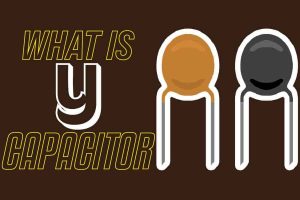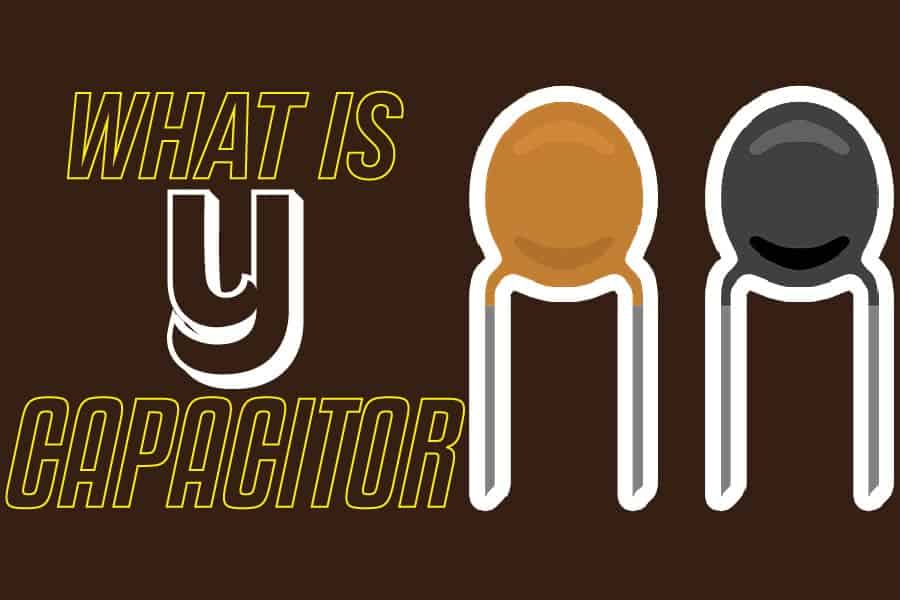
What is a capacitor? A capacitor, also called a condenser, is an electronic device that stores electrical energy in an electric field. The capacitance is measured in Farads, and it’s usually found on electronics such as televisions and radios. In this blog post, we will discuss what a Y capacitor is and how it works.
What Is A Capacitor?
A capacitor is an electrical device that stores energy in the form of a static electric charge. It can be found in many different electronic devices such as flashlights, remote controls, and smoke detectors. A capacitor contains two metal plates separated by an insulator (called dielectric), and the plates are charged with equal but opposite charges.
The capacitance is measured in Farads (F). A capacitor that can store one coulomb of charge at a potential difference of one volt has an energy capacity of approximately 0.180 joules, which means it can hold about 12% of its charge over one hour.
There are two types of safety capacitors: X capacitors and Y capacitors. The X capacitor is the most commonly used electronic device. The Y capacitor is more expensive but has better insulation properties, making it safer when working with high voltages, making it suitable for use in power supplies and other applications where an increased level of safety is required.
What Is Y Capacitor?
The Y capacitor is a bypass capacitor that reduces electromagnetic interference (EMI) by acting as inductor and filter. It is essential to minimize the effects of EMI. The Y capacitor does this by acting as both an inductor and filter, reducing electromagnetic interference (EMI) that may cause unwanted noise on your power supply lines or harm sensitive devices connected directly into them with no protection at all! It can be called either a “filter” cap for its ability to filter line noise or an “inductor” for its ability to act as a choke.
It’s essential to know the different types of interference that Y capacitors can cause. For example, they have mainly been used in SMPS(Switched Mode Power Supply) Circuits. Still, one primary source is electromagnetic interference due to high-frequency switching mechanisms built with MOSFET or IGBT, which produce lots of noise when rectified at low voltage levels needed for small Signal/Noise ratio operations as power supplies do–even without using any kind of filtering network! This makes it vital to reduce these sources where possible if you want your signal quality not only good but excellent.
Another source of electromagnetic interference is from crosstalk between different power supply lines. This happens when a voltage spike on one line induces a similar voltage in another nearby but separate line, usually through magnetic coupling or capacitive cross-coupling. The Y capacitor acts as both an inductor and filter by working as a choke to reduce EMI by preventing voltage spikes on one line from inducing voltages in nearby lines.
A Y capacitor is usually made of metalized polypropylene film dielectric, but it can be constructed with other materials like mylar or metalized paper. The advantages to using the standard PP ferrite material are that they have good self-resonant frequency, low inductance, and sound insulation resistance. PP is the most common material used because it has a lower cost than other materials like C0G ceramics or metalized polyester film dielectric capacitors with similar electrical properties.
How Does Y Capacitor Work?
The Y capacitor is a simple way to reduce the effects of electromagnetic interference. When we increase our frequency, capacitors produce less reactance and thus filter out higher-pitched noises like those heard from an electric motor or power line: they Grounded through these low capacity components by blocking them with their charge instead.
Keep in mind that one of the Y Capacitor’s terminals is always linked to the earth, while the other terminal is connected to Neutral or Line. Y capacitors are capacitors with an extremely high value. They don’t let any through under normal conditions, which implies that Y capacitors provide perfect isolation between line and earth, as well as neutral and earth. Whenever an electromagnetic field emerges, it creates a low-impedance channel between the bar and the ground or neutral, allowing the noisy current to be readily grounded.
What Are Y Capacitors Used For?
The primary purpose of a Y Capacitor is to ground undesirable high-frequency noisy impulses and thereby avoid electromagnetic interference. As a result, Y capacitors are commonly found in SMPS, sine wave inverter, and chopper circuits.
The Y capacitor avoids leakage and loud current from reaching the LISN Resistor by bypassing it. The Y capacitor likewise reduces the common-mode(CM) noise signals.
When Does Capacitor Reliability Become Essential For Safety?
When your capacitor is working, you don’t notice it. It doesn’t need to be tested and maintained as a battery does. Most capacitors can last up to 20 years before they start failing to do their job well enough that we notice them not doing their jobs anymore. To guard against differential mode interference, capacitors are inserted between the line and the neutral. Their failure does not result in a deadly electric shock, but it does pose a fire hazard. This means that the failure of a capacitor can be enough to start a fire.
Y Capacitor FAQs
What is the difference between the Y capacitor and Z capacitor?
The letters are just an easy way to remember which one you should use where. The “Z” stands for zero, so it’s used when there isn’t a reference line around against which you can measure voltage potentials (like with three-phase power). Since earth ground will always be present, the Z capacitor uses it as a reference point and filters out all differential noise. The “Y” stands for your grounding system (as referenced to earth ground).
What is an example of how y capacitors can be opened?
A Y Capacitor’s two terminals are usually connected with a wire or by screws attached to lugs. A Y capacitor’s terminals may be connected to a resistor, diode, or another device to provide a path for current flow when the capacitor fails to short-circuit and opens up. If it shorts out, there is usually no additional damage beyond what was caused by the initial fault condition that led to its failure in the first place.
What is the difference between a Y Capacitor and an X capacitor?
A Y capacitor has one connection point to the earth, while an X capacitor is more flexible because it can have two terminals that are not both connected to the ground. They’re often used for filters or impedance matching in communication circuits. The “X” stands for cross, so it’s used when you have two reference lines around against which you can measure voltage potentials (like with three-phase power).
What are the benefits of using a Y capacitor?
Y capacitors provide perfect isolation between line and earth, as well as neutral and earth. Whenever an electromagnetic field emerges, it creates a low-impedance channel between the line and the ground or neutral, allowing the noisy current to be readily grounded.
What is an example of where Y capacitors can fail?
The primary purpose of a y capacitor is to ground undesirable high-frequency impulses, avoid electromagnetic interference, and reduce common-mode noise signals by bypassing it with low impedance. Failure of a y capacitor can result in noticeable noise and hum.
Can Y capacitors explode?
No, they are not considered hazardous materials in the same way batteries can be if they short out or burst into flames under certain conditions. However, a capacitor can overheat and start a fire through uncontrolled internal sparks within the device due to sparking across its terminals when it is defective.
What is the Y capacitor made of?
A Y capacitor has both an inductive component and a capacitive one. Still, it’s usually made of metalized polypropylene film dielectric because it has the best self-resonant frequency, low inductance, good insulation resistance, and lower cost than other materials like C0G ceramics or metalized polyester film dielectric capacitors with similar electrical properties. The Y capacitor is a simple way to reduce the effects of electromagnetic interference by grounding noisy high-frequency impulses and thereby avoiding electromagnetic interference. As a result, these are commonly found in SMPS, sine wave inverter circuits, and chopper circuits.
What happens in the event of a Y capacitor failure?
When an ideal y capacitor fails, it shorts out. This creates heat in the internal sparks that may cause damage to nearby components or even lead to a fire if it is bad enough. However, they are not considered hazardous materials like batteries can be if they short out or burst into flames under certain conditions.
Conclusion
A Y capacitor is a filter that helps to ground high-frequency noise impulses and thereby avoid electromagnetic interference. It does this by using the principle of impedance matching for an electrical circuit, which has three ports (or nodes) with different impedances. It’s most commonly used in circuits with inductors or other components to generate electromagnetic fields across power lines, such as motors and transformers.
The primary purpose of a Y Capacitor is to eliminate these undesired impulses by grounding them before they can interfere with sensitive electronics like computers and televisions. They can last up to 20 years before they start failing to do their job well enough for you to notice them not doing their jobs anymore.
Similar Posts:
- How Long Does A Capacitor Hold Charge?
- How Long Does A Capacitor Hold Charge?
- Where Do You Find Earth In Minecraft?
- What Are Kml Files?
- 11 Best Noise-Canceling Earmuffs For Sleeping: Buying Guide & Review
- Best AM4 CPU Cooler: Top 12 Picks Of 2021
- Zoom: How To Enable Background Noise Suppression?
- What Is H1 H2 H3 On A Transformer?
- The 10 Best AM/FM Signal Boosters
- Top 10 Best Ethernet Cables For Gaming Review In 2022: A Buying Guide
